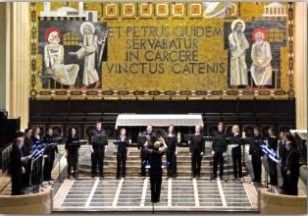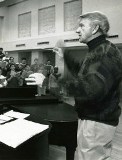
Celebrating Thomas and the VAE
Singing is called “the first art.”

In Cincinnati that means the Vocal Arts Ensemble -- the best of the first, as it were.
Thanks go to Elmer Thomas, who took his
cue from local singers Jeannie Geraci and Thomas Sherwood in 1979 to found the
all-professional chorus. Thomas, who led the VAE for its first ten years,
returned to conduct the VAE's first ever Founder’s Concert Dec. 11 at St. Boniface
Church in Northside and Dec. 12 St. Peter in Chains Cathedral downtown. The concert was also a celebration of Thomas, emeritus
professor of choral studies at the University of Cincinnati College-Conservatory
of Music, who turned 80 in October.

Dubbed "Bach's Mary," it was an exquisite program, exquisitely sung, and an occasion to fall in love with the VAE all over again. This reviewer attended the concert on Dec. 12, an afternoon with a major snowstorm alert. The church was more than half full, however, and the 20-voice chorus transported its listeners with Johann Sebastian Bach’s "Magnificat" ("My soul magnifies the Lord"), wreathed by Marian music going back to the 10th century. There were also classic carols, a carol sing along and to seal the Bach connection, the final chorus, “Dona nobis pacem" ("Grant us peace"), from Bach's great Mass in B Minor.
Alumni(ae) of the VAE joined the current membership in "Dona nobis pacem," including Cathedral music director Anthony DiCello and Neal Hamlin, director of music at Hyde Park Community United Methodist Church. Further testifying to Thomas and the VAE’s legacy were VAE alumni Ben Basone of Armstrong Chapel United Methodist Church in Indian Hill and Thom Mariner, co-editor of Express, who sang the entire program with the chorus.
After a pair of “Ave Marias,” one from the 10th century and one by Spanish composer Tomas Luis de Victoria, the church rang with the joyous opening of Bach’s "Magnificat," the Virgin Mary’s response to the angel Gabriel when told she would give birth to Jesus.
It was a beautifully, fittingly baroque performance, with piccolo trumpets, oboes d’amore and harpsichord accompaniment. If the sound bounced around in the church, it was a glorious sound and, no doubt, Old World churches have always responded similarly.
The twelve-part work is a treasure of inspiration, with its contrasting arias and choruses. Soprano soloist YoonGeong Lee was perfect in “Et exultavit” (“And my spirit has rejoiced”), as was Krista Cornish Scott in “Quia respexit” (“For he has regarded”). The modesty of the young Mary was captured both vocally and instrumentally in “Quia respexit” by both Scott and oboist Connie Ignatiou.
Bass Basone projected handsomely in “Quia fecit” (“For He that is mighty”). The blend of alto and tenor (Stacey Sands and Tony Beck) was luscious in “Et misericordia” (“And there is mercy”), with warm, low flutes played by Susan Magg and Barbara Lambert.
Alto Janice Hammond’s rich voice was well matched to “Esurientes” (“He has filled the hungry”), as were harpsichordist Christina Haan’s “echo” trills which imitated those of the flutes. Resonant tenor Wesley Lawrence put the requisite assertiveness in “Deposuit" (“He has cast down”). Trumpeters Chris Kiradjieff, Wesley Woolard and Stephen Campbell cast a golden glow over the entire ensemble in the outer movements and in “Fecit potentiam” (“He has showed strength”).
The five-part chorus was buoyant and full in “Omnes generationes” (“All generations”). Thomas’ leadership was positively magic at the end, where the voices dovetailed precisely with the orchestra into a subtle decrescendo.
More Ave Maria’s followed, from Josquin des Prez and Anton Bruckner. Josquin’s was well matched to the Cathedral, full of clarity and with a sublime “Amen” on a widely spaced open fifth that Thomas allowed to linger softly. Bruckner’s late 19th-century work was lush, even ravishing by contrast.
British composer Kerry Andrew’s 2005 setting of the 13th-century poem “Hevene Quene” brought the reverence up to date musically with spellbinding polytonal harmonies. The effect was like hearing angels singing through a door left ajar.
Moses Hogan’s arrangement of “Glory, glory, glory to the Newborn King” injected a touch of swing into the program and featured wonderful solo voices.
Hymns of the Virgin Mary included Michael Praetorious’ “Lo, How a Rose Ere Blooming,” “My Dancing Day” (arranged by Alice Parker and Robert Shaw), and “In the Bleak Midwinter," arranged by Gustav Holst. Holst’s touching anthem was nuanced and tender, with lots of rubato (flexible tempo) and shaded dynamics.
When it came time for the audience to sing along, they must have felt very special with the VAE “accompanying them with lovely descants on “O Come All Ye Faithful” and “Hark, the Herald Angels Sing.” “Silent Night” was re-harmonized, with the Cathedral chimes joining in softly at the end.
Twenty VAE alumni(ae) participated in Bach's“Dona nobis pacem," which brought the concert to a heartfelt conclusion.
A sensation of a different kind awaited listeners on Plum Street outside the Cathedral where Linus-sized snowflakes – the kind you can catch on your tongue (“A Charlie Brown Christmas”) – were coming down.